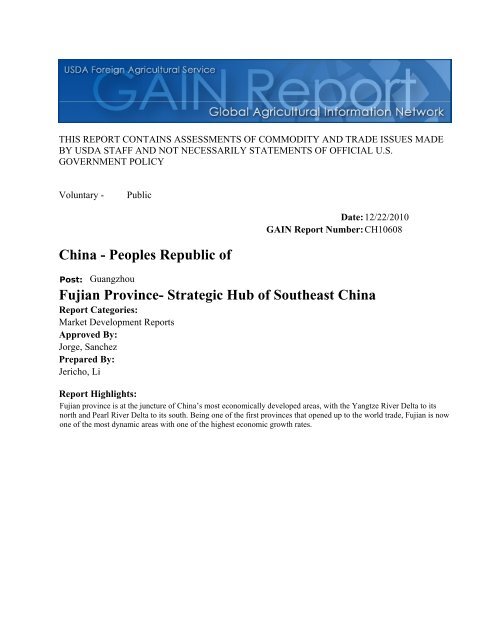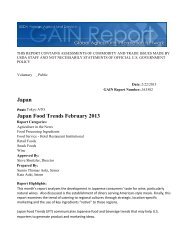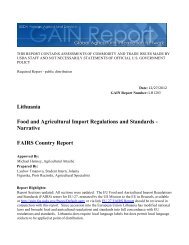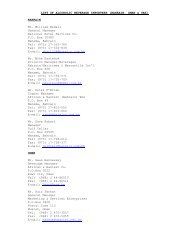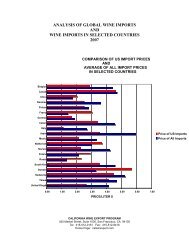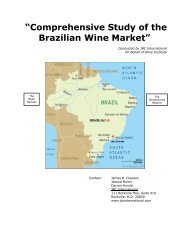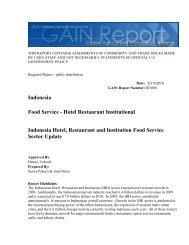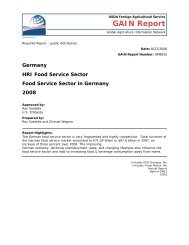China - Peoples Republic of Fujian Province- Strategic Hub of ...
China - Peoples Republic of Fujian Province- Strategic Hub of ...
China - Peoples Republic of Fujian Province- Strategic Hub of ...
You also want an ePaper? Increase the reach of your titles
YUMPU automatically turns print PDFs into web optimized ePapers that Google loves.
THIS REPORT CONTAINS ASSESSMENTS OF COMMODITY AND TRADE ISSUES MADEBY USDA STAFF AND NOT NECESSARILY STATEMENTS OF OFFICIAL U.S.GOVERNMENT POLICYVoluntary -PublicDate: 12/22/2010GAIN Report Number: CH10608<strong>China</strong> - <strong>Peoples</strong> <strong>Republic</strong> <strong>of</strong>Post: Guangzhou<strong>Fujian</strong> <strong>Province</strong>- <strong>Strategic</strong> <strong>Hub</strong> <strong>of</strong> Southeast <strong>China</strong>Report Categories:Market Development ReportsApproved By:Jorge, SanchezPrepared By:Jericho, LiReport Highlights:<strong>Fujian</strong> province is at the juncture <strong>of</strong> <strong>China</strong>’s most economically developed areas, with the Yangtze River Delta to itsnorth and Pearl River Delta to its south. Being one <strong>of</strong> the first provinces that opened up to the world trade, <strong>Fujian</strong> is nowone <strong>of</strong> the most dynamic areas with one <strong>of</strong> the highest economic growth rates.
General Information:OverviewLocated on the southeastern coast <strong>of</strong> <strong>China</strong>, <strong>Fujian</strong> <strong>Province</strong> is one <strong>of</strong> the most strategic area in <strong>China</strong> with 123,100square kilometers. It borders Guangdong to the south, Jiangxi to the west, and Zhejiang to the north, and bounded byTaiwan across the Taiwan Strait to the east. Its capital city is Fuzhou.<strong>Fujian</strong> province is at the juncture <strong>of</strong> <strong>China</strong>’s most economicallydeveloped areas, with the Yangtze River Delta to its north andPearl River Delta to its south. Being one <strong>of</strong> the first provinces thatopened up to the world trade, <strong>Fujian</strong> is now one <strong>of</strong> the mostdynamic areas with one <strong>of</strong> the highest economic growth rates.<strong>Fujian</strong> <strong>Province</strong>History<strong>Fujian</strong> was founded in the early Han dynasty (202,B.C.). Theprovince has witnessed its prosperity in economy and culture inthe history for a long period <strong>of</strong> time. During the Song Dynastyand Yuan Dynasty, the opening-up <strong>of</strong> ports and launching <strong>of</strong>Maritime Silk Road allowed <strong>Fujian</strong> to have more frequentoverseas trades and exchanges, enabling the province to enter intothe heyday <strong>of</strong> economy. It was during this period that Quanzhouand Xiamen became major trading ports in <strong>China</strong>. During theMing Dynasty and Qing Dynasty, the silk textile industry, sugarindustry, tea industry, shipbuilding industry and papermakingindustry <strong>of</strong> <strong>Fujian</strong> were well developed.Since the late 1970s, the economy <strong>of</strong> <strong>Fujian</strong> along the coast hasgreatly benefited from its geographic and cultural proximity toTaiwan.Population (2009): 36,270,000Capital (largest city): FuzhouGDP (2009): $176 billion (12th)GDP per capita: $4,890 (10th)Import trade (2009): $54.4 billionExport trade (2009): $26.8 billionTransportation<strong>Fujian</strong> has a well-developed transportation network. It has two international airports in Fuzhou and Xiamen, and fourother branch airports. <strong>Fujian</strong> has already opened more than 200 domestic and international routes. The airport in Xiamenbecame the fifth city in <strong>China</strong> to open air routes to America, following Beijing, Shanghai, Guangzhou and Shenzhen.<strong>Fujian</strong> has one <strong>of</strong> the most mature ocean transportation in <strong>China</strong>. The province has the most advantageous conditions toconstruct deep water harbors. The largest deep water ports are in Xiamen, Fuzhou, Meizhou Bay and Sanduao, amongwhich the Xiamen Harbor is one <strong>of</strong> the tenth largest harbors in <strong>China</strong>. Furthermore, 54 other ports can accommodateships <strong>of</strong> 10,000 tons or more and they provide easy commercial shipping to all the domestic ports. Fuzhou and Xiamen<strong>of</strong>fer direct sailing services to Taiwan and Gaoxiong. The coastal areas have regular daily ferry services to Jinmen andMazu islands.
EconomySince 1978 when <strong>China</strong> opened to the outside world, <strong>Fujian</strong> has received significant investment from overseas <strong>Fujian</strong>people, Taiwanese and foreign investers. Special economic zones have been established at Xiamen and Fuzhou in orderto stimulate foreign investment and trade. In 2009, <strong>Fujian</strong>’s GDP was about $176 billion, a rise <strong>of</strong> 12% from theprevious year. It’s GDP per capita was $4,890, ranking the 10 th among other provinces in <strong>China</strong>. Besides, <strong>Fujian</strong> is awell-cultivated farmland with a variety <strong>of</strong> agricultural products. Rice is the main crop, supplemented by sweet potatoesand wheat and barley.[9] Cash crops include sugar cane and rapeseed. <strong>Fujian</strong> leads the provinces <strong>of</strong> <strong>China</strong> in longanproduction, and is also a major producer <strong>of</strong> lychees and tea. Seafood is another important product, with shellfishproduction especially prominent.<strong>Fujian</strong> will also be the major economic beneficiary <strong>of</strong> the opening up <strong>of</strong> direct transport with Taiwan which commencedon December 15, 2008. This includes direct flights from Taiwan to major <strong>Fujian</strong> cities. In addition, ports in Xiamen,Quanzhou and Fuzhou will upgrade their port infrastructure for increased economic trade with Taiwan. <strong>Fujian</strong> is also thehost <strong>of</strong> <strong>China</strong> International Fair for Investment and Trade annually, which is held in Xiamen to promote foreigninvestment for all <strong>of</strong> <strong>China</strong>.Foreign Agricultural Import<strong>Fujian</strong> is one <strong>of</strong> the economic engines in <strong>China</strong>. A well-developed transportation network has helped the province tobecome a major gateway <strong>of</strong> imports from all over the world. And Xiamen is being developed as a distribution andprocessing hub to other cities in <strong>Fujian</strong> and South <strong>China</strong>. <strong>Fujian</strong> province’s economic boom has increased the purchasingpower <strong>of</strong> its consumers. Many companies in Xiamen are exploring U.S. import opportunities. By now, many U.S.agricultural products including wine, wood pulp, soybean, wheat, poultry and frozen potato products are importedthrough Xiamen port. Xiamen port ranks the tenth largest in <strong>China</strong> and 21 st in the world. It handles 70 percent <strong>of</strong> importand export <strong>of</strong> <strong>Fujian</strong> province. In 2008, over $440 million worth <strong>of</strong> U.S. agricultural products entered the Xiamen port,and the number <strong>of</strong> imports continued to grow in 2009. ATO Guangzhou is working closely with the Trade DevelopmentBureau in <strong>Fujian</strong> to provide trade servicing support to <strong>Fujian</strong> enterprises. At the end <strong>of</strong> October in 2010, ATOGuangzhou supported a wood seminar organized by U.S. S<strong>of</strong>t Woods Association held in Xiamen introducing ATO’sservices to both U.S. exporters and South <strong>China</strong> wood buyers.For more information about other cities in <strong>Fujian</strong> province, please refer to our city pr<strong>of</strong>ile, or contact ATOGuangzhou <strong>of</strong>fice.


